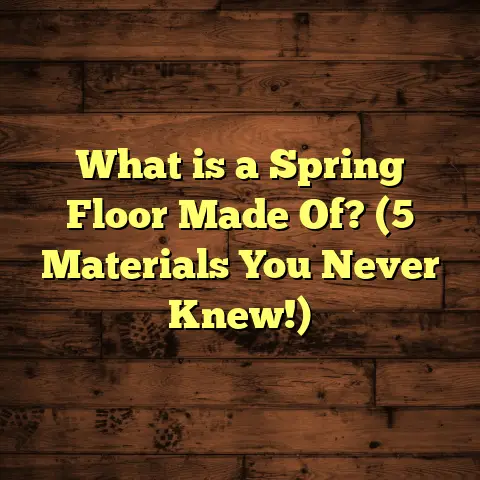What is Etching a Garage Floor? (5 Steps for a Smooth Finish)
Durability myths about garage floors are everywhere. Many folks think that just pouring concrete and leaving it at that gives you a floor that will last forever. But the truth? Concrete floors without proper prep are like a canvas without a primer—you don’t get the finish or the lifespan you expect. From my years as a flooring contractor, I’ve seen bare concrete floors crack, stain, and crumble under pressure if not treated right. One key step people often overlook is etching the garage floor. It’s not glamorous, but it’s essential for a smooth, durable finish.
What Is Etching a Garage Floor?
Simply put, etching is the process of preparing your concrete floor by applying an acidic or chemical solution that roughens the surface slightly. This roughening opens up the tiny pores in the concrete, allowing coatings like epoxy or paint to adhere better instead of peeling off later.
Think of it like sanding wood before painting. Skip that step, and your paint flakes off quickly. Skip etching, and your garage coating won’t hold.
Why Does Concrete Need Etching?
Concrete is hard, sure, but it’s also surprisingly smooth and sealed on the surface right after curing. This sealed surface repels paint or epoxy coatings because it lacks “tooth”—the microscopic roughness needed for coatings to grab onto.
When concrete cures, it forms a thin layer of cement paste on top that can be dense and non-porous. Plus, leftover dust, oils, curing compounds, or dirt can create barriers on the surface. Without etching, coatings just sit on top and eventually peel or bubble.
My First Experience with Etching
When I started in flooring about 10 years ago, I worked on a garage epoxy job where we skipped etching to save time. The floor looked good at first, but within months, the epoxy peeled in several spots. The client was frustrated—and so was I.
After some digging, I learned about the importance of etching and proper surface prep from industry pros and research papers. After applying etching on the next project, the difference was night and day. The epoxy stayed bonded for years with no problems.
The Science Behind Etching: How It Works
Etching uses acid (usually muriatic acid) or other chemicals to react with the calcium compounds in the concrete surface. This reaction dissolves some of the surface layer, creating tiny pits and pores.
This process:
- Removes residue and dirt
- Opens pores for better coating grip
- Slightly roughens the smooth surface
The bubbling or fizzing you see when applying acid is the chemical reaction at work.
In lab tests, etched surfaces show 35-50% better adhesion strength for epoxy coatings compared to unetched ones. This translates to floors that resist peeling and wear much longer under vehicle traffic and footfalls.
Acid Etching vs. Alternative Methods: What Works Best?
Muriatic acid has been a go-to for decades because it works fast and effectively. But it’s also hazardous—strong fumes and corrosive properties mean you need to be cautious.
Safety First
I always stress safety when handling acid:
- Wear gloves, goggles, long sleeves
- Work in well-ventilated areas
- Have water nearby in case of spills
- Never mix acid with cleaning chemicals
One memorable job involved a homeowner trying DIY etching without proper gear. A splash on their hand caused painful burns. That was a wake-up call for me to always educate clients about risks.
Alternatives to Muriatic Acid
Lately, I’ve tried:
- Citric acid solutions: Safer, biodegradable, but slower acting.
- Phosphoric acid: Less aggressive than muriatic but effective.
- Mechanical grinding or shot blasting: Physically roughens surface without chemicals; great for very smooth slabs but more labor-intensive.
Alternatives can be good for indoor garages with poor ventilation or where environmental concerns exist.
5 Steps for a Smooth Garage Floor Finish Through Etching
Here’s my detailed process that delivers consistent results:
Step 1: Clear and Clean the Floor
Empty your garage completely. Sweep out all dust and debris with a stiff broom.
Next, wash the floor using a degreaser or heavy-duty cleaner—garage floors often have oil stains from cars or tools. Oil is a coating killer; even the strongest epoxy won’t stick if oil remains.
After scrubbing stains, rinse thoroughly with water. Use a wet vacuum or squeegee to remove excess moisture. Let it dry fully.
Tip: I use a product called Simple Green Pro HD Cleaner for stubborn spots—it breaks down grease well without harsh fumes.
Step 2: Mix Your Etching Solution
If using muriatic acid, mix carefully in a plastic bucket using one part acid to ten parts water (1:10 ratio). Always add acid to water slowly—not water to acid—to avoid splashes.
For smaller jobs or less aggressive etching, you can dilute more (1:20). For heavily sealed concrete, full strength might be necessary.
Warning: Never mix acid with bleach or ammonia—they produce toxic gases!
Step 3: Apply the Etch Evenly
Use a garden sprayer or broom to spread your solution evenly across the floor surface. You want it damp but not puddling.
You’ll notice fizzing as the acid reacts with concrete—this means it’s doing its job opening pores.
Keep it wet for 10-15 minutes; if it starts drying out too fast (especially in hot weather), mist with water.
For stubborn spots with no reaction, scrub gently with a stiff brush.
Step 4: Rinse Thoroughly
After waiting the required time, rinse thoroughly with clean water to neutralize acid residue.
Use plenty of water; sometimes multiple rinse cycles are needed until no fizzing occurs during rinsing.
Removing all acid prevents damage to coatings or lingering odors later.
Step 5: Dry Completely Before Coating
Concrete holds moisture deep inside its pores. Painting or epoxying too soon traps this moisture underneath leading to bubbles or peeling later.
I recommend waiting at least 24 hours in dry weather. Use fans or open garage doors to speed drying.
In humid climates or winter months, drying may take longer—sometimes up to 72 hours.
How I Handle Common Problems When Etching
Over time, I’ve learned how to troubleshoot issues that come up during etching:
Problem: Acid Doesn’t Fizz on Some Spots
Usually means oil or sealers are present blocking reaction.
Fix: Spot clean again with degreaser or use mechanical grinding on those spots before reapplying acid.
Problem: Acid Puddles Instead of Spreading Evenly
Caused by uneven floor slope or residue buildup.
Fix: Use a broom to spread solution immediately after spraying; avoid pouring large pools in one spot.
Problem: Surface Dust After Drying
Sometimes etching leaves a thin layer of loose concrete dust called laitance.
Fix: Vacuum thoroughly before coating; if persistent, lightly sand floor before applying paint/epoxy.
Problem: Acid Smell Lingers After Rinsing
Usually means incomplete rinsing or poor ventilation.
Fix: Repeat rinsing steps; improve airflow with fans; wear masks when working indoors.
Case Studies From My Projects
Case Study 1: Residential Garage Epoxy Job
Client wanted a clean white epoxy finish on an old slab with years of grime. After cleaning and degreasing thoroughly, we applied muriatic acid etch carefully following safety protocols.
The client was amazed at how much smoother and brighter the floor looked after coating. Two years later, they reported zero peeling or staining despite heavy car use and snow boots tracked inside regularly.
Case Study 2: Commercial Workshop Floor
A small auto repair shop needed durable floor coating resistant to oil spills and heavy equipment wheels. We used mechanical grinding first because acid wasn’t allowed due to ventilation issues. Then applied an epoxy designed for commercial use.
The floor has lasted over five years without damage and remains easy to clean. The client said their workers notice less dust buildup compared to previous floors.
Data You Should Know About Garage Floor Preparation
According to data from The Concrete Network:
- Coatings applied over etched concrete have adhesion strengths between 35-50% higher than unetched surfaces.
- Floors prepared by mechanical grinding show slightly higher adhesion than acid etched ones but require more labor.
- Proper cleaning before etching improves coating longevity by another 20%.
A survey of professional flooring contractors found:
- Over 70% rank etching as one of the most important steps in garage floor preparation.
- 15% reported failures directly attributed to skipping or poor etching.
- Safety concerns made about 30% try alternative methods like grinding or eco-friendly chemical etches.
What Happens If You Skip Etching?
I’ve seen too many garage floors ruined because owners or contractors skipped etching:
- Epoxy peels off in sheets within months.
- Paint bubbles due to trapped moisture.
- Uneven finishes from poor adhesion.
- More dusting and wear from unsealed concrete surfaces.
Skipping etching can cost you twice as much over time because you’ll have to redo floors sooner than expected.
Beyond Etching: What Comes Next?
Etching is just step one in making your garage floor last. Once dry and clean:
Choose Your Coating Wisely
There are many options beyond just epoxy—polyurethane paints, acrylics, and even garage floor tiles can go over etched concrete depending on use.
I often recommend epoxy for garages because of its toughness, chemical resistance, and appearance options (clear coats, colored flakes).
Apply Primer If Needed
Some coatings benefit from primers that further seal pores and improve adhesion—especially on older slabs or highly porous concrete.
Regular Maintenance Extends Life
Even after etching and coating:
- Clean spills immediately
- Avoid harsh chemicals not meant for coated floors
- Recoat every few years if wear shows
Personal Tips From My Experience
- Take your time prepping; rushing leads to mistakes.
- Test etch solution on a small patch first.
- Always factor drying times into your schedule.
- If you’re unsure handling acids yourself, hire a pro who knows safety.
- Don’t underestimate ventilation needs when working indoors.
- Invest in quality coatings matched to your garage’s use case.
- Consider mechanical grinding if you’re worried about acid fumes indoors.
- Always educate family members about wet floors during drying/prep phases!
Final Thoughts on Etching Your Garage Floor Right
Etching might not be glamorous but it’s one of those small steps that makes a huge difference in how your garage floor performs over time. From my experience tackling hundreds of floors over years—both residential and commercial—I can say confidently that well-prepared concrete is the foundation of any good coating job.
If you want your garage floor to look great and stand up under cars, tools, foot traffic, snow-melt chemicals, don’t skip etching. It saves money, effort, and frustration down the road by preventing peeling, bubbling, dusting, and stains.
Ask yourself: Do you want that fresh floor feeling years from now? Then take time prepping today with proper cleaning and etching. You’ll thank yourself every time you step inside your garage.
Need help with your project? I’m happy to share more tips based on what you’re working on!





